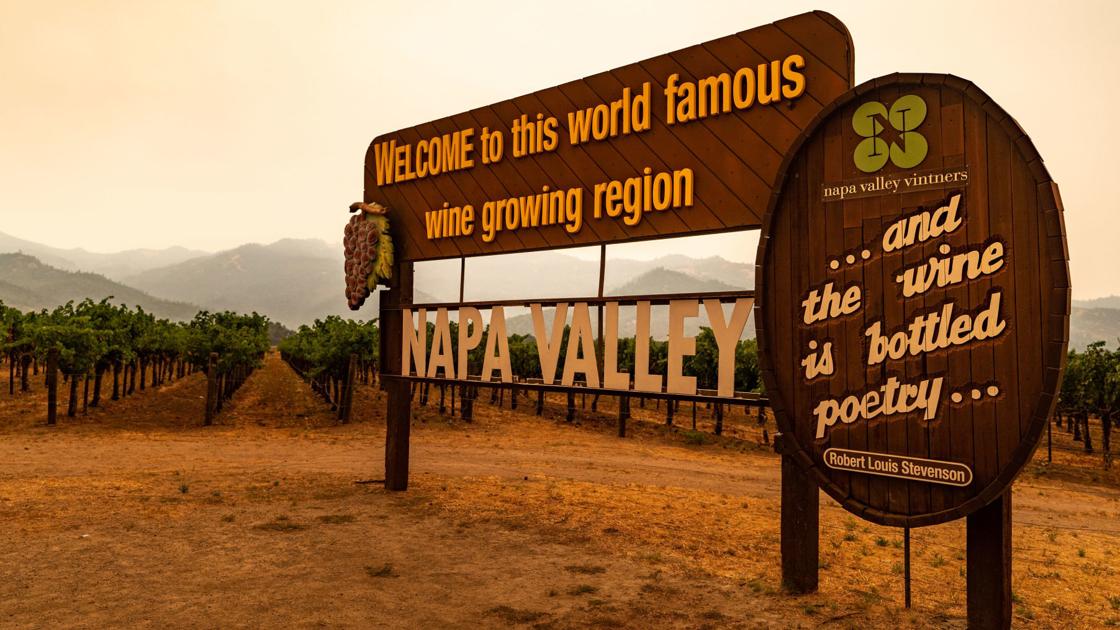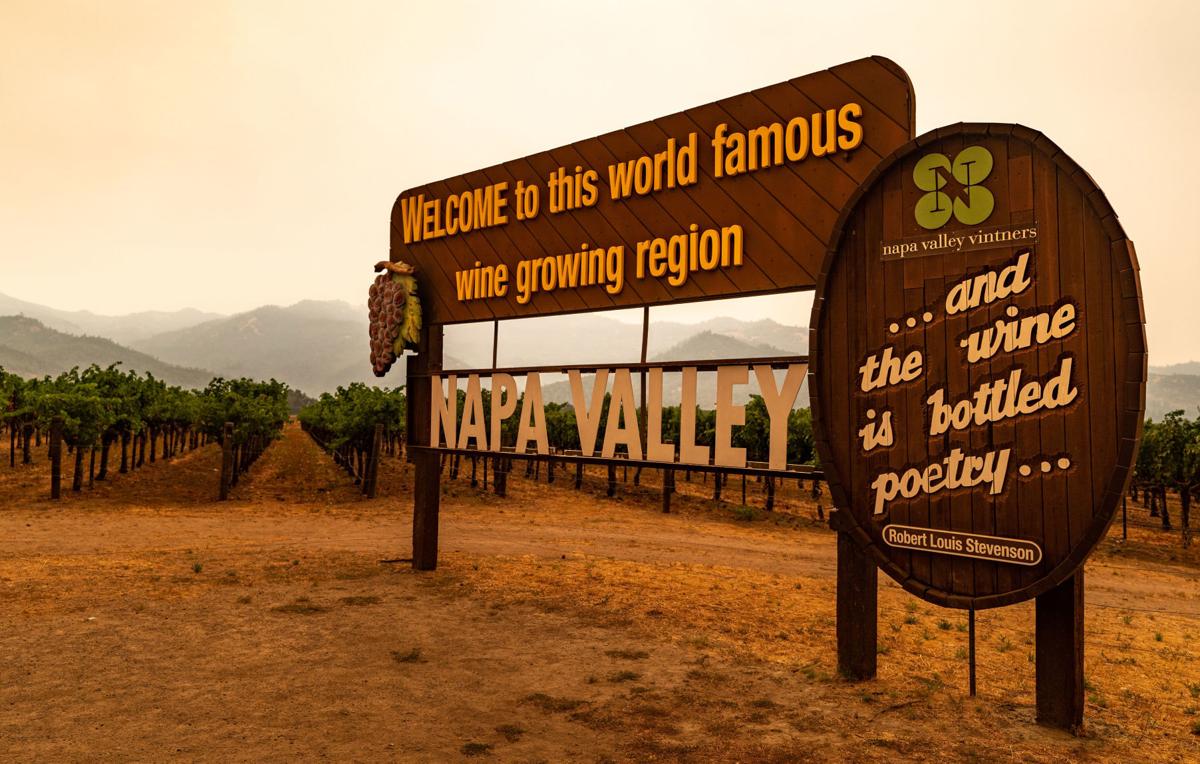
Widespread concern over wildfire smoke could alter the course of Napa Valley’s wine grape harvest this year, industry members say.
Smoke has drifted intermittently into Napa Valley over the past month – first from the Hennessey Fire that in August scorched almost a third of Napa County, then from wildfires ravaging other portions of California to the valley’s north and south.
The haze set off alarm bells for Napa's wine industry; it brought with it the threat of smoke taint in which small particles of burnt materials are absorbed by wine grapes and released during the fermentation process. When those particles - called volatile phenols - do get absorbed, they ultimately yield wine with a discernible and undesirable smoky character, essentially ruining it.
The challenge is knowing whether grapes have actually absorbed the smoke around them, because the presence of smoke around vineyards by no means guarantees smoke-tainted grapes, researchers have said. There are “markers” of smoke taint – the presence of specific compounds that when elevated can sometimes indicate the presence of volatile phenols -- but even those are not always definitive.
“The problem is the marker compounds for smoke actually exist naturally in grapes, too,” Dr. Anita Oberholster, enology specialist at UC Davis whose research has focused on smoke taint, said in an interview in February. “There’s not always a direct correlation between grape analysis and what ends up in wine.”
Still – growers around the North Bay are doing what they can to understand the impact of smoke on their crop this year. Almost all have turned to testing – many have sent grape or wine samples to the St. Helena-based ETS Labs, one of only a handful in the country offering smoke taint analysis.
The lab has continually prepared for surges in demand since the wildfires in 2017 wreaked havoc on Napa's wine grape crop, according to ETS founder and President Gordon Burns. But this year’s demand has exceeded that surge expectation by “tenfold,” in part because most crop insurance policies now require smoke taint testing to trigger insurance payouts.
The lab is working as fast as it can, Burns explained, but demand is so high that it’s created a significant backlog; existing clients may wait between a month and six weeks to receive test results, and samples from new clientele will be processed "not sooner than November," the lab's website states.
“We have taken all of our analytical capacities and redirected them toward the smoke issue,” Burns said. It would be “foolish", he cautioned, to believe the entirety of this year’s grape crop ruined.
“We have smoke over a very, very large area. Wine grapes are only grown in a tiny fraction of that area to start with, and there are so many other variables that certainly some people could be impacted and others not at all," he said.
The lab does explain to clientele that while the markers it tests for are the best known indicators of smoke taint, they may not always be definitive, according to Burns.
Still, the simple threat of smoke taint has been enough to make some in the grape market skittish, according to Glenn Proctor, partner at the bulk wine and grape brokerage firm Ciatti Company.
“It’s hard when you’re trying to take a grape crop that you want to pick at a certain time, under certain conditions with certain expectations, and then smoke (presents itself) as such a big question mark,” Proctor said.
The uncertainty has shifted dynamics of the bulk wine market, according to Proctor. He's seen vintners come onto the market to purchase bulk wine from previous vintages, hoping to use the 'clean' wine as a kind of “insurance policy” against the possibility of losing what they’d contracted for in 2020. Sellers of excess wine from previous vintages have removed their inventory from the market for the same reason - worried they may need it after all.
Growers in premium regions like the Napa Valley under normal circumstances do not often turn to the bulk market to sell or purchase wine; their grapes are often contracted for far in advance. But even those grower-vintner relationships, heralded by the region's wine industry, have not gone untested by the smoke, Proctor said. Though he's largely seen efforts to work collaboratively, some buyers are asking vintners to wait on harvesting their fruit until the smoke taint test results come in. And there have been rumblings about growers deciding not to pick at all.
“There are a lot of different strategies being employed to try and understand a situation that will to some degree be continually hard to understand,” Proctor said of how premium growers are dealing with the threat of smoke taint. “When we have more results back, they will still have to interpret that information and decide what it means and what they want to do. We’re seeing people act differently depending (on their situation).”
That could mean taking into account whether a grower has adequate insurance, Proctor added.
But crop insurance is not designed to make growers whole, according to Shannon Antonini, vice president of Insurance Sales at American AgCredit in Santa Rosa. Policies for grape growers cover between 50% and 85% of a year’s crop and use base pricing to set the insured price per ton.
The 2020 base insurance rate for Napa Cabernet Sauvignon is $6,400 per ton, according to Antonini. Napa Valley’s crop report put the average price per ton for Cabernet Sauvignon at $7,941 (though industry members say those numbers have been inflated by long-term contracts over the years).
About 75% of Antonini’s clientele have an open notice of damage – essentially the first step in the process of claiming damage on a crop, she said, noting the notices were not exclusively smoke-related. Smoke taint is covered by crop insurance, she said, though it is the hardest kind of damage to prove.
“There isn’t a visual (that comes) with it, so coverage is dependent on the smoke taint testing,” she said. Insurance companies have set their own thresholds for damage, according to Antonini; grapes showing anything less than .5 parts per billion of guaiacol or 4-methyl guaiacol, ‘smoke’ compounds, is for insurance purposes not considered damaged.
“That’s where it gets tricky from an insurance standpoint,” Antonini said, noting that different varieties of grapes often display the markers differently. Grapes testing under that threshold could ultimately still present smoke taint later into fermentation.
Growers do not have to avoid harvesting their grapes until they receive test results, according to Antonini. They usually just need to provide a pre-harvest sample. (Growers should speak with their insurance agents for more information about how to properly file a claim.)
Fire came so close to Hesperian winemaker Phillippe Langner’s vineyard on Atlas Peak in 2017 that it burned his irrigation system, he said. His initial instinct that year was not to harvest and to file for crop insurance, he said, but Gallo, who had contracted with him for a portion of the vineyard’s grapes, took the fruit after it tested below the threshold for smoke taint compounds.
Langner used the rest of the fruit in some of his blends, he said. Any smoky character he thought he'd detected completely disappeared once the wine was in barrel, he said, leaving him “flummoxed”.
This year, fire was two miles away from that same vineyard -- though smoke from the flames was not as intense, according to Langner. His buyer this year, an individual, is concerned nonetheless, and has sent small samples of fermenting grapes to ETS for testing.
“If the numbers are not good, then she won’t take it, and I get it,” Langner said, adding he is again prepared to file for insurance. It's simply too early to understand what, if any, impact the smoke had on his grapes, he said. From industry peers, he’s heard “everything and its opposite” about lab test results, and more news comes out each day.
B Cellars and its growers have mutually acknowledged that they will likely not receive results of smoke taint testing for grapes under contract, according to B Cellars General Manager Curtis Strohl.
“We basically just made deals with everybody – unless we have a known positive, we’re going to pick the grapes,” Strohl said
Even if the results the winery's growers receive are unfavorable, B Cellars will try to avoid an “all or nothing” scenario, Strohl said - either rejecting everything and paying nothing or accepting the entire crop and paying full price. Dependent on markers and sensory analysis, which B Cellars plans to perform later into fermentation, the winery and its growers may decide to sell the wine on the bulk market and split proceeds, according to Strohl.
“We’ve gone back to the growers and said, 'We’re all partners – let’s maximize return and minimize loss for each other," Strohl added.
The situation could remain dynamic until the fires are completely contained, Ciatti’s Proctor said - not just in the Napa Valley, but in wine grapegrowing regions up and down the West Coast. Adding to the uncertainty is that smoke taint detection remains a work actively in progress.
“I think we’ll learn more as we go, but we still have to harvest – and there’s a lot of harvest left to go,” he said.
Watch now: Harvest 2020 begins at Schramsberg
You can reach Sarah Klearman at (707) 256-2213 or sklearman@napanews.com.
Subscribe to our Daily Headlines newsletter.
September 16, 2020 at 01:43AM
https://ift.tt/3hvbabH
After hazy weeks, threat of smoke taint lingers over Napa Valley grape crop - Napa Valley Register
https://ift.tt/3eO3jWb
Grape




No comments:
Post a Comment